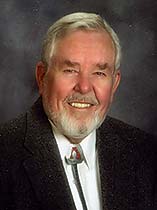 |
| John Urbanek, creator of the relief map so treasured by Moab locals. Photo courtesy of the Urbanek Family. |
John Urbanek had a life-long love affair with landscapes and with maps. Originally from Kansas, John served as a Navy pilot during the Korean War, observing the lay of the land from a birds-eye view. His love of the outdoors drew him to a career working for the National Park Service, eventually landing in Moab with his wife Anne in 1971. While pouring over maps of obscure back country, John spent countless hours exploring the cliffs and canyons of our region’s parks and surrounding landscapes. When he retired from the Park Service in 1985, John began work on a topographic sculpture of the Moab area. Referred to as “The Urbanek Map” and now considered a local treasure, John and Anne Urbanek donated the completed map to Moab Museum in December, 2005, eleven years before his passing in 2010.
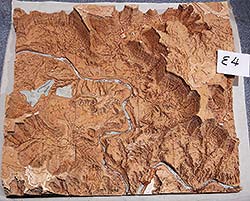 |
| Segment E4 is one of the 21 sections that make up the Urbanek Map. |
When Museum renovations were completed in March 2019, management and staff enacted a new approach to collections care which included the recruitment of professionally certified and equipped conservators to treat objects and documents in most need of special care including cleaning and repair. The Urbanek Map has been among the first to receive such care. In 2020, the Museum requested the expert assistance of Sculpture and Objects Conservator,
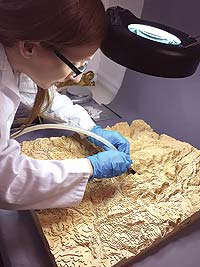 |
Kim removes dust and debris with a fine nozzle attachment on the vacuum and a soft brush, particularly useful for treatment of the narrow canyons and winding rivers. This part of treatment comes after testing the stability of pieces and verifying that there are no loose pieces that could be picked up by the vacuum cleaner. Photo courtesy of Ruby Collins-Peynaud. |
The Urbanek Map has served as a beautiful example in the art classes Kim teaches, where she has instructed students to create their own topographic models from foam, influenced by the careful attention to detail demonstrated by John Urbanek. Kim explained to her students that they, like Urbanek, can create great, detailed artwork by using their keen observation skills, their love of a subject matter (like land, in Urbanek’s case), and their hands.
Community members will be able to join a live conversation and demonstration of the map conservation process with Sculpture & Objects Conservator Kimberleigh Collins-Peynaud and the Museum’s Curatorial & Collections Manager Tara Beresh on Tuesday, March 2nd at 6:30pm MDT on Zoom and Facebook Live. Details can be found on the Museum’s website: moabmuseum.org.
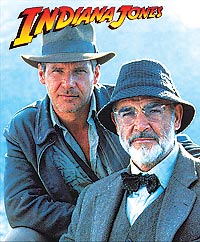 Red Cliffs Lodge, on the banks of the mighty Colorado River, is home to the Moab Museum of Film & Western Heritage. The lodge is built on the old George White Ranch, a key location for nine of the big westerns including Rio Grande, Cheyenne Autumn, Ten Who Dared, The Commancheros, and Rio Conchos.
Red Cliffs Lodge, on the banks of the mighty Colorado River, is home to the Moab Museum of Film & Western Heritage. The lodge is built on the old George White Ranch, a key location for nine of the big westerns including Rio Grande, Cheyenne Autumn, Ten Who Dared, The Commancheros, and Rio Conchos.
The late George White was founder of the Moab to Monument Valley Film Commission, the longest ongoing film commission in the world.
In the museum one can learn more about film locations, how the sets are built, and how the filming process is managed on nature’s own sound stage. On display in the museum are production photographs, movie posters, autographed scripts, props from the many pictures filmed in the area, and displays about the western ranching heritage. For information, call Red Cliffs Lodge at 435-259-2002.
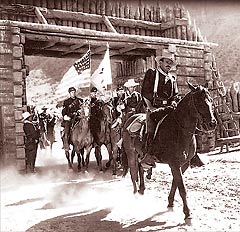 Through the magnificent landscapes of southeastern Utah, writers have been inspired and stories born here. Zane Grey, the famous western novelist, traveled through the area in 1912. His visit inspired him to write his book Riders of the Purple Sage. The book was made into a movie starring Ed Harris and Amy Madigan, and filmed on locations around Moab.
Through the magnificent landscapes of southeastern Utah, writers have been inspired and stories born here. Zane Grey, the famous western novelist, traveled through the area in 1912. His visit inspired him to write his book Riders of the Purple Sage. The book was made into a movie starring Ed Harris and Amy Madigan, and filmed on locations around Moab.
| A partial list of stars that have made movies in Moab John Wayne, Maureen O'Hara, Henry Fonda, Lee Marvin, Rock Hudson, Jimmy Stewart, Richard Boone, Anthony Quinn, Mickey Rooney, Shirley Temple, Kris Kristofferson, Billy Crystal, Robert Duvall, Gene Hackman, Bill Murray, Jack Palance, Susan Sarandon, Geena Davis, Ted Danson, Tom Cruise, and many more. |